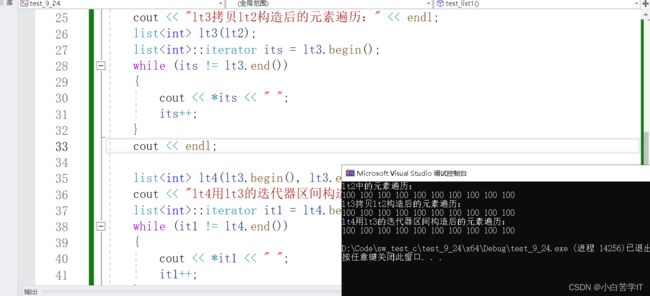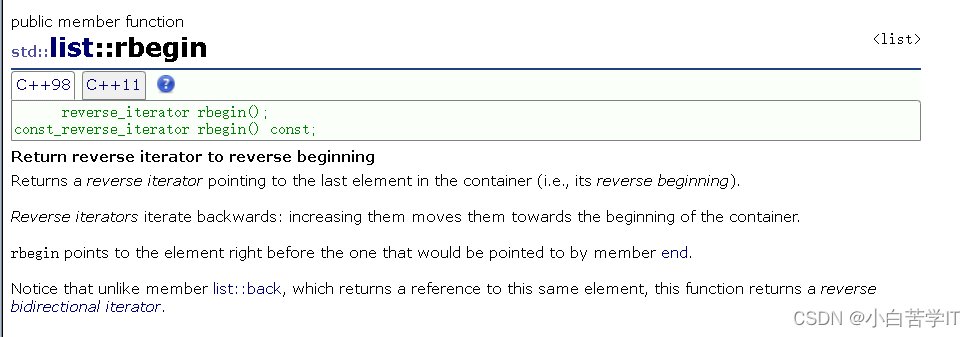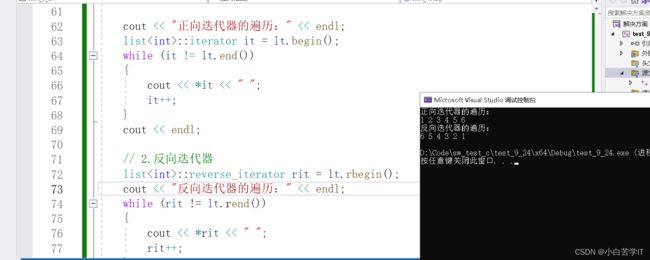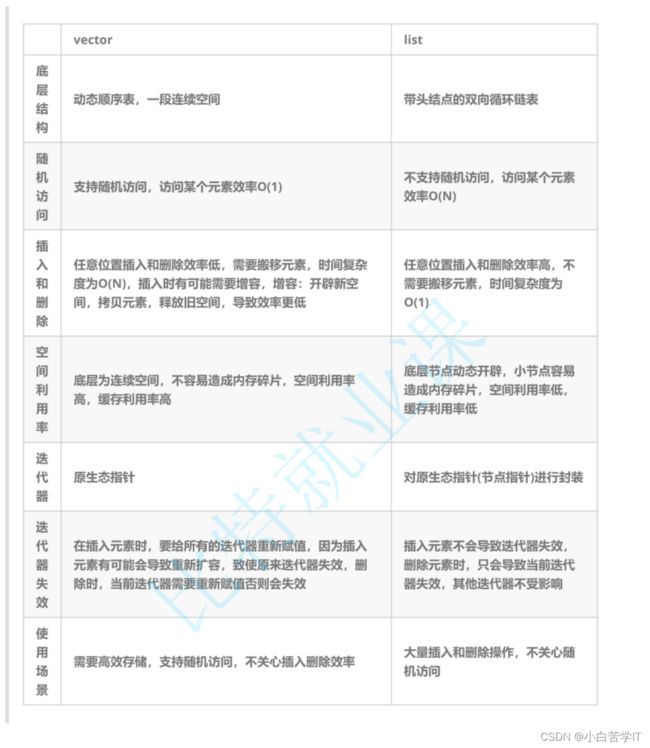C++标准模板库STL——list的使用及其模拟实现
1.list的介绍
list的文档介绍
1. list是可以在常数范围内在任意位置进行插入和删除的序列式容器,并且该容器可以前后双向迭代。
2. list的底层是双向链表结构,双向链表中每个元素存储在互不相关的独立节点中,在节点中通过指针指向
其前一个元素和后一个元素。
3. list与forward_list非常相似:最主要的不同在于forward_list是单链表,只能朝前迭代,已让其更简单高效。
4. 与其他的序列式容器相比(array,vector,deque),list通常在任意位置进行插入、移除元素的执行效率更好。
5. 与其他序列式容器相比,list和forward_list最大的缺陷是不支持任意位置的随机访问,比如:要访问list的第6个元素,必须从已知的位置(比如头部或者尾部)迭代到该位置,在这段位置上迭代需要线性的时间开销;list还需要一些额外的空间,以保存每个节点的相关联信息(对于存储类型较小元素的大list来说这可能是一个重要的因素)
list的基本结构图
2.list的使用
我们这里可以简单看一下文档里面关于list各种构造函数的介绍
2.1list的构造
目前我们只掌握这四种构造函数的使用方法
代码案例
#include
#include
using namespace std;
void test_list1()
{
list lt1; //1.这里我们构造了一个空的list对象
list lt2(10, 100); // 2.这里我们通过用构造了10个100的方式构造了lt2
//由于list不支持随机访问,所以下面我们需要借助迭代器遍历一下lt2
cout << "lt2中的元素遍历:" << endl;
list::iterator it = lt2.begin();
while (it != lt2.end())
{
cout << *it << " ";
it++;
}
cout << endl;
cout << "lt3拷贝lt2构造后的元素遍历:" << endl;
list lt3(lt2);
list::iterator its = lt3.begin();
while (its != lt3.end())
{
cout << *its << " ";
its++;
}
cout << endl;
list lt4(lt3.begin(), lt3.end());
cout << "lt4用lt3的迭代器区间构造后的元素遍历:" << endl;
list::iterator it1 = lt4.begin();
while (it1 != lt4.end())
{
cout << *it1 << " ";
it1++;
}
cout << endl;
}
int main()
{
test_list1();
return 0;
}
代码运行结果:
2.2 list 迭代器 iterator 的使用
迭代器分为正向迭代器和反向迭代器,像begin() 和end()返回的是正向迭代器,rbegin()和rend()返回的是反向迭代器,然后这两种迭代器又可以和const进行结合形成上面c++11新加的cbegin()和cend(),crbegin()和crend(),其对应的迭代器名称也要跟着变化,我们可以看一下文档中的这些函数的说明,
注意
iterator T* 可读可写
const_iterator T* 只读
const iterator 这样实现是迭代器本身不能修改
const_iterator 重新定义的一个类型,做到的是本身可以修改,但是指向的内容不能修改
下面我们通过代码举个例子
测试代码:
void test_list2()
{
//迭代器的使用,我们就简单通过常用的正反向迭代器进行说明,
//前面加了const的迭代器只需要记得不能修改迭代器所指向的内容
//1.正向迭代器,我们用简单的遍历list元素来说明
list lt;
lt.push_back(1); //在list里面插入6个结点
lt.push_back(2);
lt.push_back(3);
lt.push_back(4);
lt.push_back(5);
lt.push_back(6);
cout << "正向迭代器的遍历:" << endl;
list::iterator it = lt.begin();
while (it != lt.end())
{
cout << *it << " ";
it++;
}
cout << endl;
// 2.反向迭代器
list::reverse_iterator rit = lt.rbegin();
cout << "反向迭代器的遍历:" << endl;
while (rit != lt.rend())
{
cout << *rit << " ";
rit++;
}
cout << endl;
}
注意
1. begin与end为正向迭代器,对迭代器执行++操作,迭代器向后移动
2. rbegin(end)与rend(begin)为反向迭代器,对迭代器执行++操作,迭代器向前移动
2.3 list的容量大小接口的使用
代码测试:
void test_list3()
{
//empty()接口和size()接口的使用,你会发现跟vector相比没有capacity()
list lt;
cout << "empty():" << lt.empty() << endl;
cout << "size():" << lt.size() << endl;
lt.push_back(1);
lt.push_back(2);
lt.push_back(3);
cout << "插入三个元素之后" << endl;
cout << "empty():" << lt.empty() << endl;
cout << "size():" << lt.size() << endl;
} 运行结果:
2.4 list访问头尾元素的接口
测试代码:
void test_list4()
{
//front()接口和 back()接口的测试
list lt;
lt.push_back(1);
lt.push_back(2);
lt.push_back(3);
cout << "遍历" << endl;
list::iterator it = lt.begin();
while (it != lt.end())
{
cout << *it << " ";
it++;
}
cout << endl;
cout << "第一个元素" << endl;
cout << lt.front() << endl;
cout << "最后一个元素" << endl;
cout << lt.back() << endl;
} 测试结果:
这个list底层是一个双向循环链表,所以通过头结点访问到第一个元素和最后一个元素比较简单,但是中间的元素就不支持随机访问了。
2.5 list Modifiers
我们先了解下以下这几个接口的使用方法
//头插
void push_front (const value_type& val);
//头删
void pop_front();
//尾插
void push_back (const value_type& val);
//尾删
void pop_back();
//在pos位置插入元素val
single element (1)
iterator insert (iterator position, const value_type& val);
//在pos位置插入n个元素val
fill (2)
void insert (iterator position, size_type n, const value_type& val);
//在pos位置插入一段迭代器区间的结点
range (3)
template
void insert (iterator position, InputIterator first, InputIterator last);
//删除pos位置的结点
iterator erase (iterator position);
//删除一段迭代器区间的结点
iterator erase (iterator first, iterator last);
//交换两个链表,实际上只需要将头结点的指针跟大小size进行交换即可
void swap (list& x);
//将链表数据清空
void clear();
下面带大家来看看我们的使用案例
测试代码:
void test_list5()
{
list lt;
//尾插
for (int i = 0; i < 10; i++)//尾插后的结点值是0 1 2 3 4 5 6 7 8 9
{
lt.push_back(i);
}
//我们这里使用简单的范围for来进行遍历
cout << "尾插后链表中的结点值为:" << endl;
for (auto e : lt)//范围for借助迭代器自动推导e的类型,自动给e赋值,自动往后++
{
cout << e << " ";
}
cout << endl;
//头插
lt.push_front(10);
lt.push_front(20); //头插这两个结点后变成:20 10 0 1 2 3 4 5 6 7 8 9
cout << "头插后的链表结点值为:" << endl;
for (auto e : lt)
{
cout << e << " ";
}
cout << endl;
//头删
lt.pop_front();
lt.pop_front();
lt.pop_front(); //头删之后变成:1 2 3 4 5 6 7 8 9
cout << "头删之后:" << endl;
for (auto e : lt)
{
cout << e << " ";
}
cout << endl;
//尾删
lt.pop_back();
lt.pop_back();
lt.pop_back(); //尾删之后变成: 1 2 3 4 5 6
cout << "尾删之后:" << endl;
for (auto e : lt)
{
cout << e << " ";
}
cout << endl;
//在pos位置插入一个值为val的结点
list::iterator it = lt.begin();
it++;
lt.insert(it, 20); //此时变成 1 20 2 3 4 5 6
cout << "在第2个结点位置插入一个20:" << endl;
for (auto e : lt)
{
cout << e << " ";
}
cout << endl;
//在pos位置插入n个值为val的结点
it++;
++it;
lt.insert(it, 5, 30);//在第4个结点的位置插入5个30
cout << "在第4个结点的位置插入5个30后:" << endl;
for (auto e : lt)
{
cout << e << " ";
}
cout << endl;
//在pos位置插入一段迭代器区间
list lt2(10, 100);
lt.insert(it, lt2.begin(), lt2.end());//将lt2的10个值为100的结点从lt的第4个结点插入
cout << "插入一段迭代器区间之后:" << endl;
for (auto e : lt)
{
cout << e << " ";
}
cout << endl;
//删除pos位置的结点 这里我们会涉及一个迭代器失效的问题,我们后面再说
it = lt.erase(it);
cout << "删除it位置的结点后:" << endl;
for (auto e : lt)
{
cout << e << " ";
}
cout << endl;
//删除一段迭代器区间的结点
it = lt.erase(it, lt.end());//我们将it以及之后的结点都删除
cout << "将it后面位置的结点都删除了" << endl;
for (auto e : lt)
{
cout << e << " ";
}
cout << endl;
//交换两个链表
//我们先看看lt和lt2的两个链表结点的值,然后交换
cout << "lt:" << endl;
for (auto e : lt)
{
cout << e << " ";
}
cout << endl;
cout << "lt2:" << endl;
for (auto e : lt2)
{
cout << e << " ";
}
cout << endl;
//交换后
lt.swap(lt2);
cout << "交换后:" << endl;
cout << "lt:" << endl;
for (auto e : lt)
{
cout << e << " ";
}
cout << endl;
cout << "lt2:" << endl;
for (auto e : lt2)
{
cout << e << " ";
}
cout << endl;
//将链表数据清空
cout << "将两个链表的数据都清空之后:" << endl;
lt.clear();
lt2.clear();
cout << "lt:" << endl;
for (auto e : lt)
{
cout << e << " ";
}
cout << endl;
cout << "lt2:" << endl;
for (auto e : lt2)
{
cout << e << " ";
}
cout << endl;
}
测试结果:
2.6 list的迭代器失效问题
前面说过,此处大家可将迭代器暂时理解成类似于指针,迭代器失效即迭代器所指向的节点的无效,即该节点被删除了。因为list的底层结构为带头结点的双向循环链表,因此在list中进行插入时是不会导致list的迭代器失效的,只有在删除时才会失效,并且失效的只是指向被删除节点的迭代器,其他迭代器不会受到影响。
void TestListIterator1()
{
int array[] = { 1, 2, 3, 4, 5, 6, 7, 8, 9, 0 };
list l(array, array + sizeof(array) / sizeof(array[0]));
auto it = l.begin();
while (it != l.end())
{
// erase()函数执行后,it所指向的节点已被删除,因此it无效,在下一次使用it时,必须先给
//其赋值
l.erase(it);
++it;
}
}
运行这段代码之后,因为迭代器失效导致运行失败
所以当我们删除了某个结点之后,迭代器需要重新赋值,而为了解决这个问题,给erase这个函数添加了一个返回值,返回一个迭代器,返回被删除的结点的后一个结点的迭代器这样用it可以接受就可以使得迭代器it再次生效
将代码改正之后:
// 改正
void TestListIterator()
{
int array[] = { 1, 2, 3, 4, 5, 6, 7, 8, 9, 0 };
list l(array, array+sizeof(array)/sizeof(array[0]));
auto it = l.begin();
while (it != l.end())
{
l.erase(it++); // it = l.erase(it);
}
} 这样就没有什么大问题了
3. list 的模拟实现
#pragma once
#include
#include
#include
using namespace std;
namespace mylist
{
template
//链表的每个结点的结构
struct list_node
{
T _data; //存放数据
list_node* _prev;//指向前一个结点的指针
list_node* _next;//指向后一个结点的指针
list_node(const T& val = T()) //构造一个结点对象
:_data(val)
, _prev(nullptr)
, _next(nullptr)
{ }
};
// T T& T*
// T cosnt T& const T*
template
struct __list_iterator //list的迭代器结构
{
typedef list_node Node; //结点
typedef __list_iterator _self; //_self就是一个实例化的迭代器
Node* _node; //结点的指针
__list_iterator(Node* node)
:_node(node)
{
}
Ref operator*() //重载运算符* 通过*能够访问结点里面的数据
{
return _node->_data;
}
Ptr operator->() //重载-> , 结构体指针访问成员可以用结构体对象->结构体成员
{
return &_node->_data;
}
_self& operator++() //重载运算符前置++,返回下一个结点的迭代器
{
_node = _node->_next;
return (*this);
}
_self& operator--() //重载运算符前置--,返回前一个结点的迭代器
{
_node = _node->_prev;
return (*this);
}
_self operator++(int) //重载运算符后置++,返回当前结点的迭代器的拷贝再++
{
Node* tmp(_node);
_node = _node->_next;
return tmp;
}
_self operator--(int) //重载运算符前置--,返回当前一个结点迭代器的拷贝再--
{
Node* tmp(_node);
_node = _node->_prev;
return tmp;
}
bool operator!=(const _self& n) //重载迭代器的比较运算符!=
{
return this->_node != n._node;
}
bool operator==(const _self& n) //重载迭代器的比较运算符==
{
return this->_node == n._node;
}
};
template
class list
{
typedef list_node Node;
public:
typedef __list_iterator iterator;
typedef __list_iterator const_iterator;
const_iterator begin() const
{
return const_iterator(_head->_next);
}
const_iterator end() const
{
return const_iterator(_head);
}
iterator begin()
{
return (_head->_next);
}
iterator end()
{
return _head;
}
void empty_init()
{
_head = new Node;
_head->_next = _head;
_head->_prev = _head;
_size = 0;
}
void clear()
{
iterator it = begin();
while (it != end())
{
it = erase(it);
}
}
void swap(list& lt)
{
std::swap(_head, lt._head);
std::swap(_size, lt._size);
}
list()
{
empty_init();
}
//lt1(lt2)
list(const list& lt)
{
empty_init();
for (auto e : lt)
{
push_back(e);
}
}
~list()
{
clear();
delete _head;
_head = nullptr;
}
list& operator=(listlt)
{
swap(lt);
return *this;
}
void push_back(const T& x)
{
insert(end(), x);
}
void push_front(const T& x)
{
insert(begin(), x);
}
void pop_back(const T& x)
{
erase(--end());
}
void pop_front(const T& x)
{
erase(begin());
}
iterator insert(iterator pos, const T& x)
{
Node* newnode = new Node(x);
Node* cur = pos._node;
Node* prev = cur->_prev;
prev->_next = newnode;
newnode->_prev = prev;
newnode->_next = cur;
cur->_prev = newnode;
++_size;
return iterator(newnode);
}
iterator erase(iterator pos)
{
Node* cur = pos._node;
Node* prev = cur->_prev;
Node* next = cur->_next;
delete cur;
prev->_next = next;
next->_prev = prev;
--_size;
return iterator(next);
}
size_t size()
{
return _size;
}
private:
Node* _head; //list的头结点
size_t _size;//list的大小
};
} 4. list和vector的比较
vector与list都是STL中非常重要的序列式容器,由于两个容器的底层结构不同,导致其特性以及应用场景不同,其主要不同如下:





















